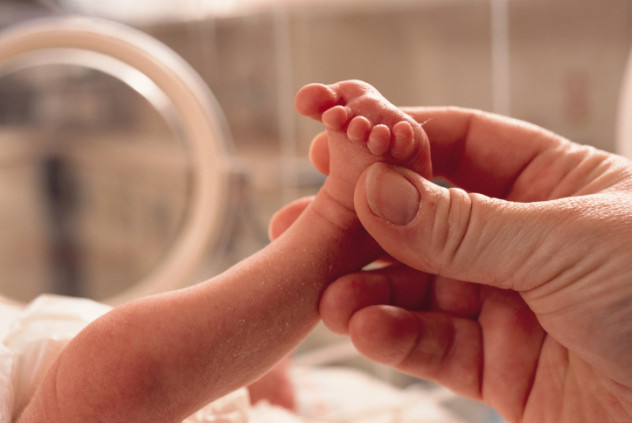 Food
Food  Food
Food  History
History 10 Odd Things Colonial Americans Kept at Home
 Weird Stuff
Weird Stuff 10 Superstitious Beliefs That Once Consumed Entire Cultures
 History
History 10 Bizarre Friendly Fire Incidents in Military History
 Technology
Technology 10 Modern Technologies That Accidentally Imitate Ancient Magic
 Mysteries
Mysteries 10 Mysteries of the Human Genome
 Weird Stuff
Weird Stuff 10 Things So Rare They’ve Only Been Found Once
 History
History 10 Legends Whose Last Moments Undid Their Glory
 Health
Health 10 Futuristic Ideas to Treat Common Medical Problems
 Weird Stuff
Weird Stuff Ten Surreal Attempts to Reverse Baldness
 Food
Food 10 Everyday Foods You Didn’t Know Were Invented by the U.S. Military
 History
History 10 Odd Things Colonial Americans Kept at Home
 Weird Stuff
Weird Stuff 10 Superstitious Beliefs That Once Consumed Entire Cultures
Who's Behind Listverse?

Jamie Frater
Head Editor
Jamie founded Listverse due to an insatiable desire to share fascinating, obscure, and bizarre facts. He has been a guest speaker on numerous national radio and television stations and is a five time published author.
More About Us History
History 10 Bizarre Friendly Fire Incidents in Military History
 Technology
Technology 10 Modern Technologies That Accidentally Imitate Ancient Magic
 Mysteries
Mysteries 10 Mysteries of the Human Genome
 Weird Stuff
Weird Stuff 10 Things So Rare They’ve Only Been Found Once
 History
History 10 Legends Whose Last Moments Undid Their Glory
 Health
Health 10 Futuristic Ideas to Treat Common Medical Problems
 Weird Stuff
Weird Stuff Ten Surreal Attempts to Reverse Baldness
10 Incendiary Facts About Incest
Most of us know that incest is wrong, either through cultural conditioning or what appear to be innate evolutionary cues, yet some humans can’t seem to resist the urge to have sex with their relatives. In fact, since the DNA of every living human is 99.9 percent the same, it may be much more common than we think. Still, that doesn’t mean incest can be acceptable in any case. As we will see, breeding with a close relative can result in some dire consequences.
SEE ALSO: 10 Royal Families Riddled With Incest
10 The Effects Of Inbreeding

Even if you believe that two consenting adults should be able to have sex with whomever they please, there’s no escaping the fact that reproducing with a close relative has some serious drawbacks. When we mate with someone with a completely different gene pool, our chance of passing on recessive genes is only 50 percent. Many times, those genes remain dormant, but when people who share a large number of genes breed, the chance of passing on conditions known as autosomal recessive disorders—conditions that are inherited through recessive genes, including cystic fibrosis, sickle cell anemia, and albinism—increases significantly.
Other side effects of inbreeding include the increased risk of infertility, birth defects like cleft palates, heart conditions, facial asymmetry, low birth weight, slow growth rate, and neonatal mortality. One study found that 40 percent of children whose parents were first-degree relatives were born with autosomal recessive disorders, congenital physical malformations, or severe intellectual deficits. According to the study, when first-degree relatives mate, the risk of their child suffering from an early death, serious birth defect, or mental disability increases to almost 50 percent.
Watch the first three incendiary seasons of Game of Thrones at Amazon.com!
9 Evolutionary Strategies Against Incest

Fortunately, Mother Nature has developed her own strategies to deter us from mating with close relatives. According to evolutionary psychologists, just observing your mother care for another baby is a cue that that other child is a sibling and discourages sexual attraction. If you happen to be the youngest, being raised with other children by the same set of parents has the same effect. This may explain why relationships with adopted family members are still considered taboo even though they don’t share the same genes.
Females are more heavily invested invested in the genetic fitness of their offspring, and experts believe that’s why women tend to be particularly averse to incest. A 1994 study showed that women might actually be able to smell the best genetic mate to father their future offspring. In the experiment, which would eventually be known as the “smelly t-shirt” test, women were asked to sniff shirts that had been worn by random men for three days and rate their scents for intensity, pleasantness, and sexiness. After analyzing the participants’ DNA, researchers found that the women preferred the scents of the men who were most genetically different from them.
A more recent study also found that couples who had the most genetic similarities also had the lowest sexual satisfaction. Women who were partnered with genetically similar mates were even more likely to cheat on their husbands. These studies suggest that genes can not only influence mate choice, but determine your overall satisfaction with your partner.
8 Inbreeding Among Animals

It’s fairly common for dog breeders to preserve desirable traits within their litters through inbreeding, but frequent inbreeding over many generations causes serious problems. Most animals suffer the same adverse effects from inbreeding as humans, such as reduced fertility, slower growth rates, increased incidence of disease, and higher mortality rates. Also like humans, many creatures have evolved to form their own anti-incest mechanisms, either by migrating away from their homes or using various cues to identify their kin. Female lemurs, for instance, can tell if a male’s genes are too similar to her own by smelling the pheromones that emit from his genitals.
Mice also use smell to identify ideal potential mates, much like the human females in the smelly t-shirt test. Experiments have shown that keeping a brother and sister mouse isolated in a cage will often result in their mating, but only if there are no other viable partners. Introducing an unrelated male compels the female to abandon her brother. If the female has already been impregnated by her brother, she can even abort the pregnancy before mating with the unrelated male.
Because hyenas don’t use scent or other cues to identify relatives, females only mate with males that are new to their group. This preference for the “new guy” forces young male hyenas to leave their families upon adulthood in search of a pack of unrelated females, resulting in low levels of inbreeding among the species.
Of course, there are exceptions. The estimated 500-percent growth of the bedbug population in recent years was partially caused by a chemical resistance to insecticides, but also the bedbug’s ability to thrive on inbreeding. When bedbugs that have this resistance to insecticide continue to inbreed, doubling up on those resistant genes strengthens the resistance of the next generation, making the parasites even harder to kill and demonstrating one of the few instances in which inbreeding can actually benefit a species.
7 Even Plants Avoid Incest

Most living things benefit from genetic diversity when breeding, including plants, which have developed their own mechanisms to prevent self-pollination. Many plants are hermaphroditic, meaning they have both male and female reproductive organs, which makes it easy to self-pollinate. To prevent this, some plants, such as petunias and tobacco plants, have evolved to develop what scientists have dubbed the “self-incompatibility” strategy.
As a part of this strategy, some plants can identify their own pollen once it has entered the female reproductive organ (called the pistil) and destroy it before fertilization occurs using a toxin called S-RNase. Though the S-RNase is produced even when genetically diverse pollen has entered the pistil, the plant prevents the destruction of viable pollen by withholding the toxin until it has identified the pollen as either compatible or incompatible.
6 The Ethics Of Incest
Some people believe that incest isn’t all that bad, especially when it’s between two consenting adults who aren’t having children. They insist that when you take reproduction out of the equation through birth control, sterilization, or homosexuality, no one is harmed by incest. Of course, the law has something to say about that.
In 2010, 46-year-old Columbia University professor David Esptein was charged with one count of third-degree incest after being accused of having consensual sex with his 24-year-old daughter. The daughter faced no charges because, in the eyes of the law, children are considered a “protected class,” even when they’re above the age of consent. The theory is that the power dynamic between a parent and a child makes consent impossible to negotiate. Even when incest occurs between siblings, the elder of the two is usually held to a higher degree of accountability.
Epstein’s lawyer has raised the argument that incest between consenting adults is no more reprehensible than homosexuality. Lawmakers around the world have disagreed with him, saying that incest is unacceptable because it destroys the family unit whereas, two unrelated gay people in a relationship form a new one. According to political author William Saletan, homosexuality is an orientation, but incest is not. Banning homosexual sex would mean that gay people wouldn’t be able to create relationships, while those attracted to a close relative can conceivably find alternate sexual partners.
Of course, the most famous incestuous relationship in recent times took place between actor Mackenzie Phillips and her famous father and founder of The Mamas & the Papas, John Phillips. We see some of the fall out in the video above.
SEE ALSO: 10 Fascinating Cases Of Historical Incest From Around The World
5 King Tut Was Weak, Frail, And Inbred
King Tut is arguably the most famous of all ancient Egyptians. His solid gold tomb was found in 1922, complete with around 2,000 treasures inside, including jewelry chests, weapons, and a royal throne decorated with silver and stones. With all this marvelous treasure, it would be easy to imagine the king as a handsome, strong, young ruler of the ancient world, but recent research has shown that Tut was frail, weakened by multiple malarial infections, and so disabled he needed a cane to walk.
While his malarial infections are at least partly to blame for his frailty, DNA testing revealed that Tut’s parents were brother and sister, which is likely why he suffered from congenital defects such as a clubfoot and cleft palate as well as a degenerative bone condition known as Kohler’s disease. In addition to being the product of incest, Tut was also a practitioner. He didn’t leave any living heirs, probably because he and his sibling wife were unable to bear children without fatal congenital disorders. Also found within his tomb were the mummified corpses of two fetuses, who are believed to be Tut’s daughters.
4 Inbreeding Destroyed The Spanish Habsburg Dynasty

Tut’s family members weren’t the only royals to dip their pens in the family ink. Throughout the ages, incest among royal families was common and even encouraged in order to retain the purity of the bloodline. For two centuries, the Spanish Habsburg dynasty refused to share their power with outsiders, so they continued to inbreed with one another. This practice eventually led to their downfall in 1700, when King Charles II died without an heir.
The Habsburg family was so intent on keeping their royal blood pure that, prior to Charles’s death, 9 of the 11 marriages recorded during the dynasty’s 200-year reign were between biological relatives. Starting in 1550, nobody within the dynasty married outside of their family. Charles himself was the offspring of an uncle-niece marriage. By some estimations, he was one of the most inbred people in history, with 95.3 percent of his genes traceable to just five ancestors. One biography described poor Charles as having an “an enormous misshapen head” and a huge tongue. He also had a jaw that “stood so much out that his two rows of teeth could not meet,” which caused frequent drooling, an inability to chew, and extreme difficulty speaking. Other accounts said the king suffered from intestinal upsets, convulsions, premature ejaculation, and impotence.
Though the dynasty may be long gone, at least its name continues to live on among dental professionals. The condition called prognathism, which is a protruding lower jaw, has been nicknamed “Habsburg jaw” in homage to the impotent, drooling, big-headed king.
3 The Incest Cult In Australia
In 2013, court documents revealed one of the worst cases of child abuse in Australia and perhaps one of the worst cases of multi-generational incest known to the world. The family, who the court appointed the pseudonymous surname Colt, was discovered living in rural New South Wales following an anonymous tip that their children were not going to school.
Shortly after arriving, authorities discovered that about 40 people were living in squalor inside two caravans, two sheds, and several tents. The compound had no sewage system, running water, toilets, showers, or baths. Among the people living there were several children, who were filthy, and shy. Few of them were able to speak intelligibly, and almost all of them had fungal infections on their feet.
Genetic tests later revealed that all of the children, except for one 5-year-old girl, were products of incest, which was believed to have begun as many as 40 years ago. The children’s genes were traced to just one set of grandparents, who were brother and sister. Eight of the children’s parents were brother and sister, mother and son, or father and daughter, while the remaining six children were born from parents who were aunt and nephew, uncle and niece, half-siblings, or grandparents and grandchild. The children themselves had sex with one another from a very young age.
Most suffered from severe health problems, including malnourishment, speech and hearing difficulties, an inability to read or write, and urgent dental problems. One 15-year-old boy had walking difficulties and severe psoriasis. His speech was barely intelligible, he regularly soiled his bed, and he was learning at a kindergartner’s level. Two other 15-year-old boys who suffered from similar disabilities were found to have been completely neglected when it came to personal and dental hygiene. A 14-year-old girl who was underweight and unable to use toilet paper or a comb suffered from severe speech and sight difficulties. She was also unable to read or write, though she was perfectly capable of threatening to cut off a caseworker’s fingers. The remainder of the children suffered from similar problems.
In total, 12 children were removed from their parents’ custody and either placed in foster homes or treatment programs to address their sexual and psychological trauma. As of 2013, the mothers of the children had hired lawyers to fight for custody, while one of the mothers faced charges in court for procuring the removal of a child from care and recruiting a child for a crime.
Travel to Australia! Don’t miss a single thing with Fodor’s Australia Travel Guide at Amazon.com!
2 Genetic Sexual Attraction

For most of us, the idea of falling hopelessly in love with a close relative is probably both disgusting and inconceivable, but for up to 50 percent of people who reunite with their siblings, parents, or offspring after separating at birth, developing obsessive feelings for a family member is a reality. These strange emotions are the result of a condition known as genetic sexual attraction (GSA), and it has reportedly become so common that post-adoption agencies warn their clients about it and provide specific training to their counselors to treat it.
Unfortunately, not much is known about GSA because most people are afraid to admit that they’re attracted to a close relative and the subject of incest is still very taboo among academics and psychologists, resulting in a lack of research on the subject. What is known is that the attraction doesn’t always lead to sex. Sometimes, it’s just an overwhelming desire to be around and touch the long-lost relative. When it does result in a sexual relationship, it’s usually between reunited brothers and sisters. One psychiatrist, who conducted one of the only known studies on the condition, cautions that there is a stark difference between traditional incest and GSA. While GSA sufferers are technically committing acts of incest, they are repulsed by the thought of having sex with family members they grew up with.
What could cause something like this to happen? According to Freud, we’re all repressing incestuous urges, and recent studies suggest that the good doctor may have been at least somewhat right. In 2010, researchers found that people tended to partner with those who resembled their opposite sex parent. Specifically, scientists found that women were attracted to men whose features resembled the central portions of their father’s faces, while men were attracted to women who shared similarities with the lower parts of their mother’s faces. An earlier study also found that men and women, respectively, opted for partners who had the same eye and hair color of their opposite sex parent, while yet another study found that children of older parents gravitated toward older partners.
The theory is that we are “imprinted” from a young age to seek out the familiar by mating with people who resemble those who raised us. According to psychologists, when you see a face that is similar to yours, you tend to believe the person it belongs to is more trustworthy and cooperative. One Scottish study found that women were most attracted to men who were essentially masculine versions of themselves. Psychologists believe that this is because overt masculinity can sometimes make women wary, and familiar facial features may help to build trust.
Though it might seem counter-intuitive, given all the issues with inbreeding, evolutionary theory says that we’re attracted to mates who resemble our parents because doing so may promote our own genes. To make sure we don’t choose partners with genes that are too similar, though, humans subconsciously employ guides such as scent to attract us towards those with sufficient genetic diversity.
1 We’re All Related Anyway

In 1987, geneticists studied the mitochondrial DNA of 147 people of different races and found that the DNA of all living people fall within one of two human lineages. One of these lineages descended solely from Africa, while the other contains traces of all other races. According to one geneticist, humans actually share more mitochondrial DNA than most primates. The mitochondrial DNA of two humans has only about half as many differences as the DNA of two other primates of the same species, suggesting that humans have a much more recent common ancestor than other primates. In fact, geneticists have traced everyone’s DNA to a single woman, nicknamed Mitochondrial Eve, who probably lived around 200,000 years ago in Africa.
If you happen to have blue eyes, you and every other blue-eyed person on Earth share a single common ancestor who lived between 6,000 and 10,000 years ago. Before this common ancestor, every human being had brown eyes. Scientists aren’t sure why blue eyes spread so quickly around Europe, but theories have sprung up that blue eyes may be more useful in certain levels of daylight or were just seen as sexually attractive to potential mates.
If you’re of European heritage, your lineage and the lineage of every European alive today can be traced to a set of ancestors that lived only 1,000 years ago, as researchers discovered after testing the DNA of over 2,000 people all across Europe. Researchers also found that, naturally, populations that lived closer together tended to be more related. Italians are slightly less related than other European populations, perhaps because they had a stable, independent population for many years, while people from the United Kingdom are more related to people from Ireland than people from other parts of the UK. Meanwhile, Eastern Europeans tend to be more related than the rest of Europe, which may be the result of the Slavic population boom that occurred about 1,000 years ago.
SEE ALSO: 10 Incendiary Facts About Incest
Eliza is a Canadian paralegal who moonlights as an occasional writer. She has a penchant for dead bodies, cats, and cheese, in that order.








